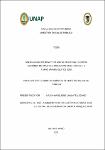Anemia ferropénica y estado nutricional en niños menores de 24 meses atendidos en el Ipress I-3 Túpac Amaru Iquitos 2020
Abstract
El método en el presente estudio fue el cuantitativo, diseño descriptivo, transversal, correlacional; tuvo como finalidad determinar la relación entre anemia ferropénica y estado nutricional en niños menores de 24 meses atendidos en la IPRESS I-3 Túpac Amaru, Iquitos 2020. La población estuvo constituida por 123 niños atendidos en el control de crecimiento y desarrollo, una muestra de 96 niños de 6 a 23 meses. La valoración del estado nutricional fue obtenida mediante los patrones de referencia establecidos por la OMS, según indicadores P/E, T/E y P/T. El nivel de hemoglobina se determinó por digito punción mediante la técnica de fotometría. Los resultados obtenidos según indicador peso para talla fueron, 27,1% fueron malnutridos y 72,9% estado nutricional normal. Así mismo según indicador talla para la edad, el 44,8% presentaron talla baja, y 55,2% talla normal. Finalmente, según indicador peso para la edad, 9,4% presentaron estado nutricional malnutrido, y 90,6% estado nutricional normal. En cuanto a anemia ferropénica, se identificó 51 (53,1%) niños (as) con anemia, 45 (46,9%) sin anemia ferropénica. Para establecer relación se sometieron estos resultados a la prueba estadística no paramétrica X2 de Pearson. se determinó que existe relación estadísticamente significativa (p < 0,05) entre ambas variables con valor de significancia bilateral p = 0,000 para el indicador peso para la talla. Así mismo para el indicador talla para la edad se obtuvo un valor de significancia bilateral p = 0,194, concluyendo que no existe relación estadísticamente significativa. The method in the present study was the quantitative, descriptive, cross-sectional, correlational design; Its purpose was to determine the relationship between iron deficiency anemia and nutritional status in children under 24 months attended at the IPRESS I-3 Túpac Amaru, Iquitos 2020. The population consisted of 123 children attended in the growth and development control, a sample of 96 children from 6 to 23 months. The assessment of nutritional status was obtained using the reference standards established by the WHO, according to P / E, T / E and P / T indicators. The hemoglobin level was determined by digit puncture using the photometry technique. The results obtained according to the weight for height indicator were, 27.1% were malnourished and 72.9% were normal nutritional status. Likewise, according to the height-for-age indicator, 44.8% had short stature, and 55.2% had normal height. Finally, according to the weight-for-age indicator, 9.4% had malnourished nutritional status, and 90.6% had normal nutritional status. Regarding iron deficiency anemia, 51 (53.1%) children with anemia, 45 (46.9%) without iron deficiency anemia were identified. To establish a relationship, these results were subjected to Pearson's X2 non-parametric statistical test. It was determined that there is a statistically significant relationship (p <0.05) between both variables with a bilateral significance value p = 0.000 for the weight-for-height indicator. Likewise, for the height-for-age indicator, a bilateral significance value p = 0.194 was obtained, concluding that there is no statistically significant relationship.
Collections
- Tesis [500]


